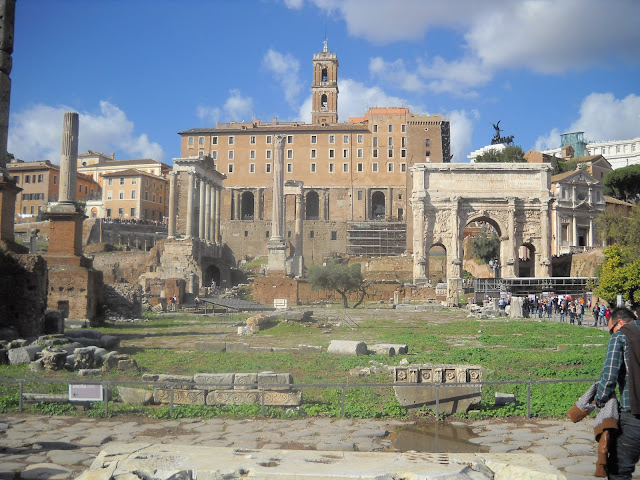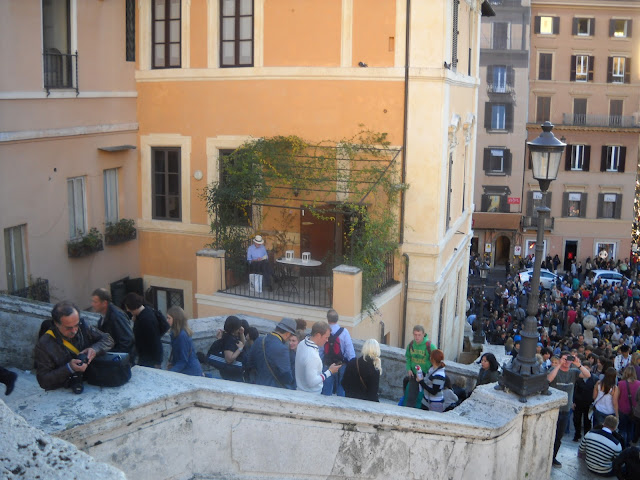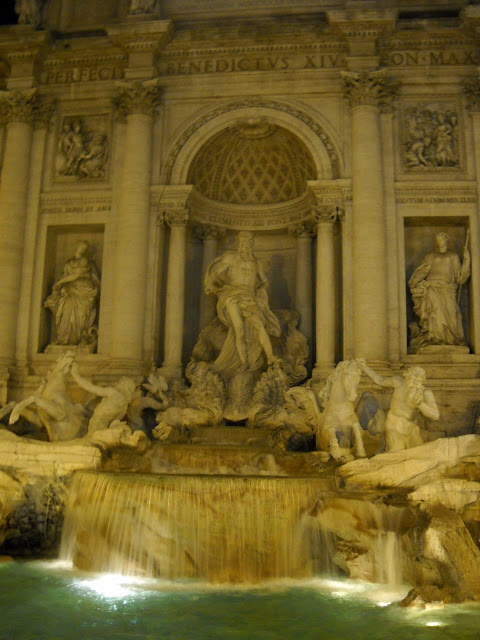Hello lovely readers! A quick note outside of the current timeline of the events I'm posting about in my blog: I'm home! I left Paris this past Saturday morning just before 11am (Paris time) and returned home to Ohio around 9 in the evening (Ohio time). And yes, I was incredibly tired. But I am ever so happy to be home. And now I have all the time in the world to work on writing about the last few things I did overseas. Hopefully all of my adventures will be documented by the end of my winter break.
Okay. Meanwhile, back in Italy...
So even though Sara and I had gotten to Rome on a Tuesday evening, it wasn't until that FRIDAY that we actually went out and really saw Rome. And we did it ALL. Rome may not have been built in a day, but it turns out you CAN experience all of Rome's major tourist attractions in about 12 hours.
We started off the day with a quick stop at the Basilica de Santa Maria degli Angeli e dei Martiri (say that three times fast). In English its the basilica of S.t Mary of the Angels and the Martyrs. It was built inside the frigidarium of the ancient Roman baths of Diocletian, and was first worked on by Michelangelo. Sara and I had gone into it the evening of our first day in Rome, as it's right across the street from the National Museum of Rome. The church isn't lit hardly at all once the sun goes down, and we could tell it was an incredibly beautiful space, so we wanted to come back when it was full daylight to really see it. And the weather that Friday was GORGEOUS. Warm and sunny the whole day, which is why we saved doing all of the big Roman attractions until then.
A very impressive organ.
The ceilings in here were SUPER high, and all of them were painted with these kinds of beautiful frescos.
The main altar.
Walking back from the church to the metro there was a group of tourists outside of a hotel getting into a series of old-school VW vans, so of course I had to take a picture of the pink one.
After that we really began our all-out marathon of Rome. Starting with the Colosseum:
The Colosseum was completed in 80 AD and was the largest amphitheater ever built in the Roman Empire with its seating capacity of 50,000 people (nowadays it can only seat a few hundred in temporary seating, since most of the rows that people used to sit on have been destroyed).
The view from the second level of the arena.
When the Colosseum was still being used, the higher up your seats were meant the lower your social status was. The group of people standing on the first level in the middle of the left0hand side of the picture are standing in what used to be the box reserved for the Vestal Virgins. The Emperor's box is directly across from it and is where you enter the Colosseum.
The floor of the arena is almost entirely gone, but the hypogeum underneath is still pretty well intact. This is where both the human and animal participants in the gladiator games would be held before it was their turn. There were originally 80 vertical shafts allowing access for participants and set pieces to pop up around the floor of the arena. During the inaugural games of the Colosseum, it is estimated that 9,000 animals alone were killed.
The view from the second level of the Colosseum looking out over Palatine Hill.
And looking across at the Roman Forum.
In the middle of the street next to the Colosseum is the Arch of Constantine, the Roman emperor who legalized Christianity in the Roman Empire. The arch was dedicated in 315 AD to commemorate Constantine's victory over Maxentius at the Battle of Milvian Bridge.
The Colosseum from near the top of Palatine Hill.
This hill is one of the most ancient parts of the city. Rome began here. Not only had people lived on this spot since around 1000 BC, but this is also, according to legend, near the spot of the cave where the she-wolf suckled Romulus and Remus before they were discovered by a local shepherd and his wife who raised them. This cave is known as the "Lupercal", and archaeologists have actually discovered a cave in the hill that may be the cave associated with the story.
Ruins of a palace.
The view (zoomed in) of the dome of St. Peter's.
The view (zoomed out) over the city with the bare ground of what used to be the Circus Maximus chariot racetrack off to the left.
Pretty landscaping amidst the ruins.
We headed from Palatine Hill straight into the Roman Forum. This cluster of temples and ancient government buildings started out as a marketplace and eventually grew into the center of all Roman life.
The arch of Titus just outside the Forum. It was the inspiration fro the Arc de Triomphe in Paris.
The Basilica of Constantine, which began as the Basilica of Maxentius, but then Constantine took it over when he defeated Maxentius and named it after himself. There used to be a 100-foot tall statue of Constantine here (fragments of which I saw later on at the Capitoline Museum). What remains of the basilica is the ancient equivalent of the side chapels in a medieval or Renaissance church. It was HUGE.
The most intact temple in the Forum.
The marble the temple is made out of was very valuable stuff in the Renaissance. People attempted to cut down the columns by sawing through them with ropes dipped in acid. You can still see the rope marks. They were, fortunately, unsuccessful, largely because the acid ate through the ropes faster than the marble...
This little hut-shaped structure above covers this mound:
Which doesn't look like much, but supposedly marks the exact spot where Julius Caesar's body was burned to great pomp and circumstance after he was murdered.
The view looking out over that spot. This open space is what is technically "the Forum."
Looking out from the opposite end of the Forum.
The arch of Sepitmus Severus.
To the left of the arch is the exit, and from there we walked up a set of stairs to come up the back of Capitoline Hill.
The mansion of the mayor of Rome.
Down the main stairs of the hill (designed by Michelangelo) and to the left of Capitoline Hill is this extremely impressive building:
It's the Museo Centrale del Risorgimento, which is a combination museum, archive, and historical research institute. The giant horse statue is a monument to Victor Emmanuel II, the first king of Italy after it was unified in the 19th century (they're real big on him here), and the statue in front of that marks Italy's Tomb of the Unknown Soldier.
About ten-fifteen minutes' walk from Capitoline Hill is the Pantheon. We stopped and had lunch at a cafe right on the corner around the back of the Pantheon where we sat outside and pondered at how unbelievably ugly the Pantheon is (with the exception of its very front).
Victor Emmanuel II, along with a handful of others including the painter Raphael, is buried here.
Then there was the obligatory daily stop for gelato. Mine was a giant ball of chocolate gelato entirely encased in whipped cream and candied hazelnuts (I have no idea how they did that).
This is also an unintentionally artsy shot of Sara.
Continuing on our quest into the center of Rome, we came across the Trevi Fountain, which was PACKED with people:
It's a very impressive bit of sculpture, but we had to be extra on our guard both here and at the Spanish Steps where we went next in particular because the crowds were so concentrated and full of people trying to sell you things or scam you or otherwise target you for obviously being a tourist.
The view from about two-thirds of the way up the Spanish Steps. We climbed all the way up and didn't linger to long. There were just too many people.
A little higher up on the steps we noticed this guy drinking an expresso and writing in a little notepad on his ADORABLE little balcony in the heart of Rome. I WANT HIS LIFE.
The church at the top of the Spanish Steps. We ducked inside for a minute.
By now the sun was going down and we had seen everything we'd wanted to see, but we also knew that we wanted to go back and see some things at night. So we got on the metro and took it back to the Colosseum:
And at the end is Trajan's Column. You can't see it in this picture, but there are over 2,500 individual figures carved around the column depicting the battles and conquests of the Emperor Trajan. During the Renaissance church leaders wanted to keep the column in place, but needed to give it an element of Christianity. So instead of Trajan up there at the top, it's St. Peter, who looks off in the direction of the Vatican.
A bit of the Forum at night.
Beautiful frescos that are original to the building, not brought in as additions to the museum's collection.
The actual famous statue of the she-wolf nursing Romulus and Remus.
Scale model of what the whole of Capitoline Hill looks like.
This painting is GIANT. Which I thought was cool.
After dinner, we had one last thing we wanted to do: see the Trevi Fountain at night.
It was still incredibly crowded, but we managed to get all the way down to the front (and yes, we threw coins over our shoulders back into the fountain--the legend says if you do, it guarantees that you'll return to Rome someday).


































































